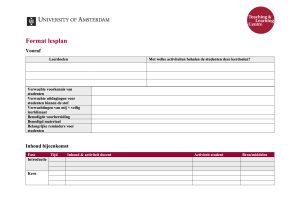
University teaching checklist: how can I make sure I’m prepared for teaching?
This checklist can be used by new lecturers to prepare for their teaching. At the bottom of the page you can download the checklist and a format for a teaching plan (Dutch).
1. Before/during the first class session
| How can I get to know my students? | You can ask students to fill out a short questionnaire in advance with to get a sense of their study academic background, motivation, expectations of the course, etc. This is a good starting point for the first lecture/seminar. |
| How can I show students who I am? | Students also want to know you as a person and a professional. Perhaps you can tell them about the research you are doing, what drives you in your research, and what you would like to teach students in this subject. |
| How can I help students understand the relevance of my course? | Explain what students will learn in this course and how it relates to the program, where it stands in relation to other courses they are following. |
| How do I ensure there’s no mismatch between the students’ expectations and my own? | To avoid frustration and confusion, it helps to ask students about their expectations in the first class, as well as giving them a sense of the structure of the course. You can also emphasize the importance of reading (specific parts) of the course manual. You may be able to integrate some of the students’ expectations in your teaching. |
2. Questions to consider before each class session
A safe learning environment is the basis for learning: when students feel safe, they ask more questions, share their opinions more readily, etc. In addition, it is useful to ask yourself what you expect students will find difficult. Here are some questions you can ask yourself before each class session:
| What do I expect from students during class? How do I communicate this? | It’s helpful to think beforehand about how you like students in your classes to demonstrate active participation. Do you want them to raise their hands before they speak, or not? Are students allowed to use their laptops, and if so, when? Make your expectations clear by discussing this during your first class session. |
| How do I create a safe learning environment? How do I communicate this? | In order to create a safe space, it is important that you, as a lecturer, refer to this explicitly, e.g.: ‘everyone in this group is equal, we listen to each other with respect, if someone feels personally attacked you can always come to me, also after the lecture.’ |
| What do I expect students will find difficult about the material? | Thinking about this beforehand will help you design your teaching more effectively. You can also ask students this at the beginning of the course, or throughout teaching – this will help you adapt your materials to their level or struggles. |
| What can I cut if I run out of time? And what do I do if there is time left? |
Thinking about this in advance will help you make well-considered choices in the heat of the moment.
When creating an education plan it’s important to keep in mind which activities are the most urgent to enable students to reach the desired learning outcomes. When you are short on time during a class this will enable you to adapt quickly. |
3. Designing a class session
When designing a course, it is helpful to use the three-step model below (Fink, 2005). These steps can always be used to create a lesson plan/teaching plan, whether for a pre-existing course or one you are designing yourself.

A class session can be structured in many different ways, and a seminar or practical will look different to a lecture. Roughly speaking, there are always three phases: an introduction, core and conclusion. Below, you will find a few guiding questions for each phase that you can use to prepare your teaching, taking into account the model above.
3.1 Introduction
| What is/are the learning objective(s) of the lecture/seminar? How can I communicate this/these? |
Make your learning objectives as concrete and specific as possible. It may help not only to present the learning objectives but also to discuss them with students and think of explicit examples. After all, learning objectives are often abstract and therefore sometimes hard to relate to for students. |
| What prior knowledge do I expect from students? How can I check this and use it in my teaching? |
Prior knowledge is not only about knowledge from previous courses, but also about what the students have understood and remembered from your last lecture or seminar. You can get a sense of this, for example, through a short quiz (Canvas Quizzes/ Wooclap) or a conversation. You can use this information to ensure students have what they need to understand the new material. |
| How can I get students to connect and respond to the material? | Scientific literature is often abstract and can be hard for students to relate to. It can be motivating to start with a current topic/event (newspaper article) or examples that students might encounter in their everyday lives, such as a documentary, video, photo, etc. |
| How do I communicate the content and structure of the class? | Students often find it helpful if you give them a clear idea of how the class will be structured. On the other hand, this leaves little room for surprises. In any case, make sure that students can always ask questions; that way you show them that you value their input. |
3.2 Core
| Do students’ learning processes correspond with your course learning outcomes? | Each learning outcome relates to one or more levels in Bloom’s taxonomy, such as remembering, understanding or applying concepts. Which classroom activities contribute to the achievement of your learning outcomes? And do they correspond to the appropriate level in Bloom’s taxonomy? Read a series of three articles on the use of learning objectives in teaching (only in Dutch). |
| How can I stimulate students’ active engagement during class? | Active learning is more effective than just listening. You can activate students in many different ways: through discussions, working together in small groups, presentations, by asking questions, etc. Would you like more inspiration? Take a look at this database of interactive classroom activities. |
| How can I encourage all students to make an active contribution? | It often happens that only a few students actively participate in a discussion, while the rest is silent. Ask yourself if this is always a bad thing: not all students feel comfortable expressing their opinion during a class discussion. However, you can expect these students to contribute in a lecture rather than in group work, for example. There are plenty of teaching methods that can be used to accommodate different styles of engagement. |
| Are my teaching methods/in-class activities varied enough? | Variety helps students concentrate and enhances the inclusivity of your classes (not all students get a chance to shine if you only hold in-class discussions, for instance). Keep in mind that students have different preferences: some like to work together, others to present or to write. |
| How can I check students’ understanding during lectures? | You can use a voting tool (e.g. Wooclap) to have students fill in multiple choice questions or an open question such as ‘What is an example of this theory that you might come across in practice? Another idea is the ‘One minute paper’ activity: let the students describe the meaning of theory X for themselves in one minute, and then they can discuss their response in pairs. An added benefit is that this temporarily shifts the focus from you to them and stimulates active engagement. |
3.3 Closing
| How can I make students aware of what they learned in my lecture? | Helping students gain awareness and insight into their own learning process is not only motivating for them, it also helps you meet your students’ needs. You can ask students to describe what they learned individually and discuss this in pairs with the whole class. It will be more effective if you ask specific and concrete questions and reflect on the course learning objective(s). |
| How can I get feedback from students on my lecture? | Involve your students in your teaching; open yourself up to their feedback. If you try something new, ask your students what they thought. Was there enough time to discuss the literature, or questions raised during the lecture, or should the emphasis be on the essay in the next class session? You can easily ask students to leave a short, anonymous evaluation via Wooclap or Microsoft Forms (or via post-it notes). |
4. Questions for reflection after the lecture
| How can I use the results of the evaluation? What can I do differently in my next seminar(s)/lecture(s)? |
Think about the importance of the role that evaluation has on your teaching and education in general. Do you understand why students have a certain opinion? How can you use their input in the near future during your teaching? It motivates students to share their opinion when they understand what is done with their feedback. In the next class session it is important to let students know what you have done with their feedback, even if you did not integrate certain feedback in your teaching. |
| How can I let students know that I have read their feedback and am taking aboard (some of) their suggestions? | It is not possible (or even desirable!) to incorporate all your students’ feedback into your teaching. However, it is important to show students that you are listening to them. E.g.: ‘Last week you said you would like to spend more time discussing the essay. I have thought about this, but unfortunately it is not feasible to incorporate this in the seminars. However, I can do this …’ |
Want to read more?
Information about content representation:
Loughran, J., Mulhall, P., & Berry, A. (2004). In search of pedagogical content knowledge in science: developing ways of articulating and documenting professional practice. Journal of Research in Science Teaching, 41(4), 370-391.
Fink, D. L. (2005). Integrated course design. Manhattan, KS: The IDEA Center. Retrieved from http://www.ideaedu.org/Portals/0/Uploads/Documents/IDEA%20Papers/IDEA%20Papers/Idea_Paper_42.pdf






